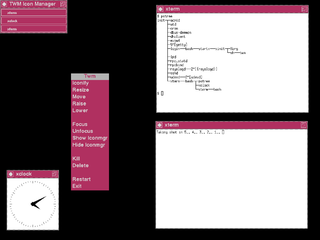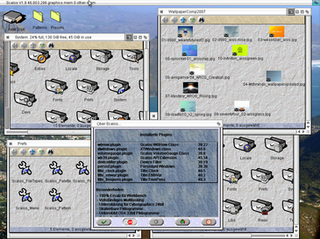
The history of the graphical user interface, understood as the use of graphic icons and a pointing device to control a computer, covers a five-decade span of incremental refinements, built on some constant core principles. Several vendors have created their own windowing systems based on independent code, but with basic elements in common that define the WIMP "window, icon, menu and pointing device" paradigm.
In computing, a desktop environment (DE) is an implementation of the desktop metaphor made of a bundle of programs running on top of a computer operating system that share a common graphical user interface (GUI), sometimes described as a graphical shell. The desktop environment was seen mostly on personal computers until the rise of mobile computing. Desktop GUIs help the user to easily access and edit files, while they usually do not provide access to all of the features found in the underlying operating system. Instead, the traditional command-line interface (CLI) is still used when full control over the operating system is required.

An X window manager is a window manager that runs on top of the X Window System, a windowing system mainly used on Unix-like systems.

Fluxbox is a stacking window manager for the X Window System, which started as a fork of Blackbox 0.61.1 in 2001, with the same aim to be lightweight. Its user interface has only a taskbar, a pop-up menu accessible by right-clicking on the desktop, and minimal support for graphical icons. All basic configurations are controlled by text files, including the construction of menus and the mapping of key-bindings. Fluxbox has high compliance to the Extended Window Manager Hints specification.

twm is a window manager for the X Window System. Started in 1987 by Tom LaStrange, it has been the standard window manager for the X Window System since version X11R4. The name originally stood for Tom's Window Manager, but the software was renamed Tab Window Manager by the X Consortium when they adopted it in 1989. twm is a stacking window manager that provides title bars, shaped windows and icon management. It is highly configurable and extensible.

A stacking window manager is a window manager that draws and allows windows to overlap, without using a compositing algorithm. All window managers that allow the overlapping of windows but are not compositing window managers are considered stacking window managers, although it is possible that not all use exactly the same methods. Other window managers that are not considered stacking window managers are those that do not allow the overlapping of windows, which are called tiling window managers.

ratpoison is a tiling window manager for the X Window System primarily developed by Shawn Betts. The user interface and much of their functionality are inspired by the GNU Screen terminal multiplexer. While ratpoison is written in C, Betts' StumpWM re-implements a similar window manager in Common Lisp.

A window manager is system software that controls the placement and appearance of windows within a windowing system in a graphical user interface. Most window managers are designed to help provide a desktop environment. They work in conjunction with the underlying graphical system that provides required functionality—support for graphics hardware, pointing devices, and a keyboard—and are often written and created using a widget toolkit.

WindowBlinds is a computer program that allows users to skin the Windows graphical user interface. It has been developed by Stardock since 1998, and is the most popular component of their flagship software suite, Object Desktop. It is also available separately, and as an ActiveX/COM component called DirectSkin. Introduced in its sixth version, it supports alpha blending effects similar to the compositing of Windows Vista, but on Windows XP.

A menu bar is a graphical control element which contains drop-down menus.
Amiga software is computer software engineered to run on the Amiga personal computer. Amiga software covers many applications, including productivity, digital art, games, commercial, freeware and hobbyist products. The market was active in the late 1980s and early 1990s but then dwindled. Most Amiga products were originally created directly for the Amiga computer, and were not ported from other platforms.

Workbench is the desktop environment and graphical file manager of AmigaOS developed by Commodore International for their Amiga line of computers. Workbench provides the user with a graphical interface to work with file systems and launch applications. It uses a workbench metaphor for representing file system organisation.
Intuition is the native windowing system and user interface (UI) engine of AmigaOS. It was developed almost entirely by RJ Mical. Intuition should not be confused with Workbench, the AmigaOS desktop environment and spatial file manager, which relies on Intuition for handling windows and input events. Workbench uses Intuition to produce displays and AmigaDOS to interact with filing system: AmigaDOS is built on Exec.
Zune is an object-oriented GUI toolkit which is part of the AROS project and nearly a clone, at both an API and look-and-feel level, of Magic User Interface (MUI), a well-known Amiga shareware product by Stefan Stuntz.

AmiKit is a compilation of 425 pre-installed and pre-configured Amiga programs running on Windows, macOS, Linux, and Amiga computers with a Vampire V2 card.
Amiga support and maintenance software performs service functions such as formatting media for a specific filesystem, diagnosing failures that occur on formatted media, data recovery after media failure, and installation of new software for the Amiga family of personal computers—as opposed to application software, which performs business, education, and recreation functions.

AmigaOS is a family of proprietary native operating systems of the Amiga and AmigaOne personal computers. It was developed first by Commodore International and introduced with the launch of the first Amiga, the Amiga 1000, in 1985. Early versions of AmigaOS required the Motorola 68000 series of 16-bit and 32-bit microprocessors. Later versions, after Commodore's demise, were developed by Haage & Partner and then Hyperion Entertainment. A PowerPC microprocessor is required for the most recent release, AmigaOS 4.

Amiga Forever is an Amiga preservation, emulation and support package published by Cloanto, allowing Amiga software to run on non-Amiga hardware legally without complex configuration.

Scalos is a desktop replacement for the original Amiga Workbench GUI, based on a subset of APIs and its own front-end window manager of the same name. Scalos is NOT an AmigaOS replacement, although its name suggests otherwise. Its goal is to emulate the real Workbench behaviour, plus integrating additional functionality and an enhanced look. As stated on its website, the name "Scalos" was inspired by the fictional time-accelerated planet Scalos in the Star Trek episode "Wink of an Eye".

Qvwm is a window manager, intended as a reimplementation of the Windows 95 interface for Linux systems. Released in 1996 under the GNU General Public License. The project's name comes from wordplay references to Japanese words and Roman numbers. In 2000, Linux Format called Qvwm "an unusually impressive imposter".











